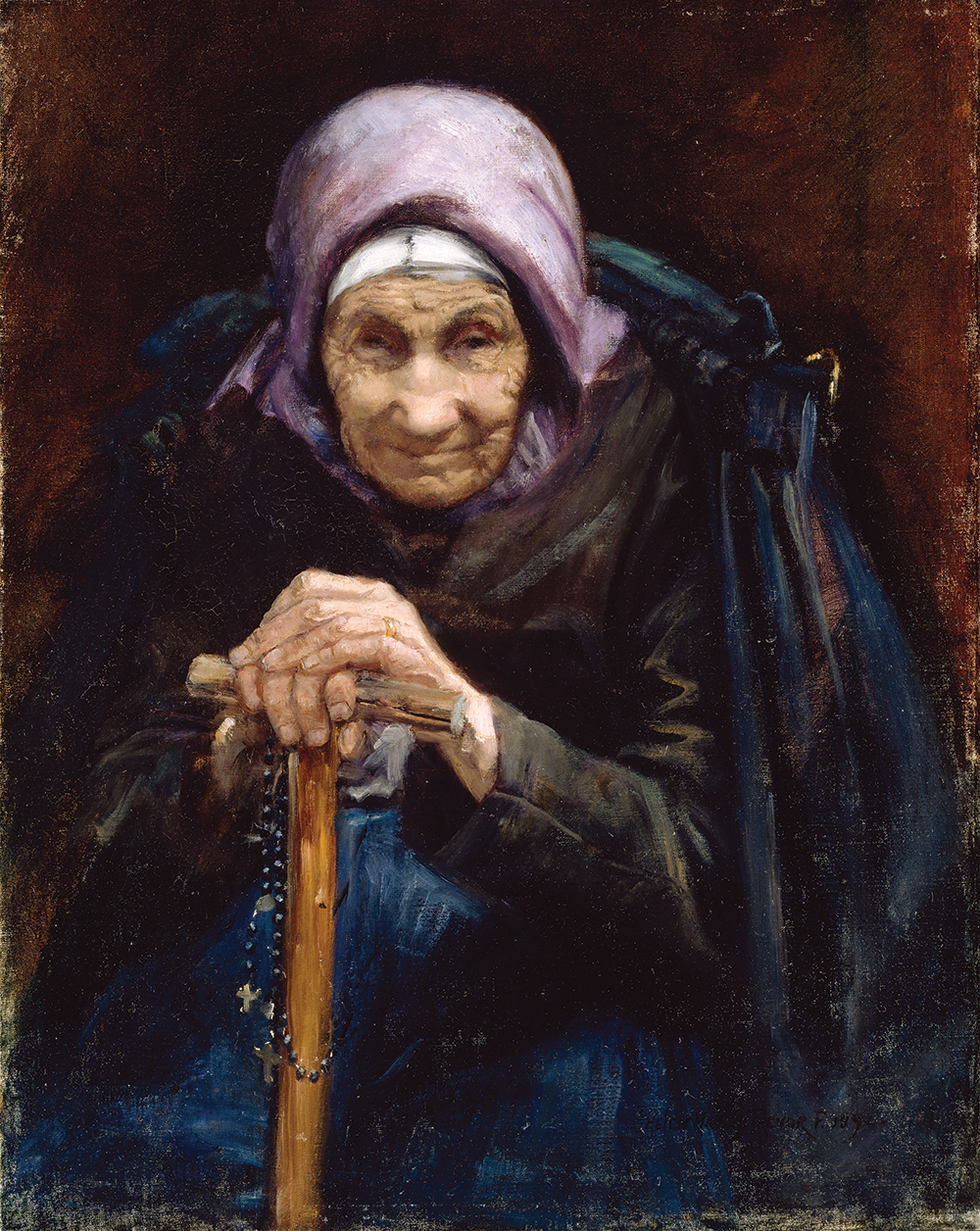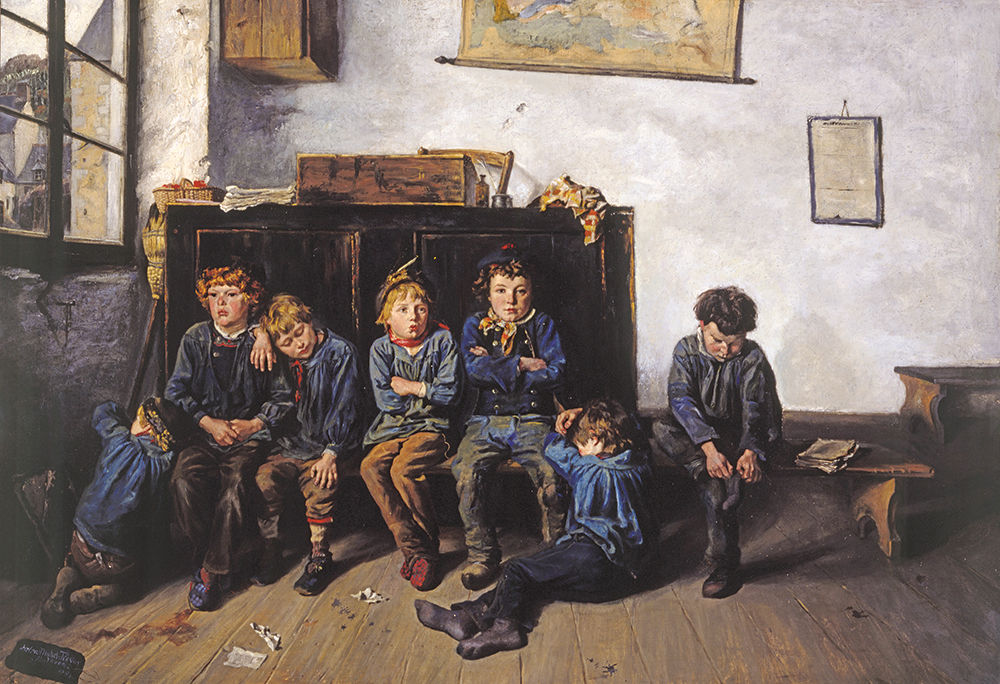Room 18 in the National Gallery of Ireland features Irish artists who studied and painted in France during the second half of the 19th century, including John Lavery, Sarah Purser and Walter Osborne. Two of Helen Mabel Trevor’s paintings also hang there. Who was Trevor, and why was her career so unusual? Carmel Coyle explains …
Helen Mabel Trevor was born into a well-to-do Church of Ireland family on a large estate, Lisnagade, in Co Down on December 20 1831, one of seven children. With the exception of her sister Rose, her siblings did not enjoy good health, and all seven children died unmarried and childless. Rose remained Helen’s constant companion throughout their lives.
There is no information as to whether Helen received any tuition in art while living at home. For a woman to aspire to having a career, much less a career as an artist, required a very determined personality and independent means to finance training and travel. Trevor had both.
Trevor showed an early gift for drawing and painting and her father built a studio for her at home. At 22, her work was exhibited in the Great Industrial Exhibition of 1853 in Dublin, held in a temporary pavilion on Leinster Lawn where the National Gallery of Ireland now stands. Over a thousand paintings by major national and international artists were exhibited, including five works by Trevor. At this time she also began to exhibit at the Royal Hibernian Academy’s annual exhibitions.
Following her father’s death in 1872, Helen moved to London with her mother and her sister Rose. In 1877 she applied for admission to the Royal Academy of Arts (RA). In 1860, Laura Herford became the first woman to be admitted to the RA – because of an oversight. She signed her entrance drawing L Herford and an offer was made to L Herford, Esq. When the error was discovered, to their surprise the Academicians found no written rule excluding women. So Miss Herford paved the way for other women artists, including Trevor, to get a professional academic training at the RA. From the second half of the 19th century, Irish artists began to move on from London for further training at academies and private studios in Paris. Around 1880, Trevor followed this trend and moved to Paris to continue her training with the French artist Carolus-Duran who was one of the preeminent portrait artists of the time. She arrived at an exciting period in the art world where the focus had moved to a more democratic art, capturing the everyday lives of ordinary people and places.

“La Mere du Marin” 1892, oil on canvas, National Gallery of Ireland.
Independent studios offered students a progressive, liberal training. Women were offered the same classes as men, including admission to life-drawing classes, in contrast to the RA and the École des Beaux-Arts which did not permit female students to study the nude until the end of the century. Paris was now attracting an international coterie of artists, particularly women, who were seeking training and professional recognition. However, women were charged higher fees than their male colleagues, the rationale being that they were unlikely to have a professional career and were merely seeking instruction for a leisure pastime.
By the middle of the 19th century, it had become popular for artists to spend time in rural artists’ colonies which began to spring up across Europe including France. They arrived from countries as far north as Sweden, as far east as Russia and as far west as America.
Artists were attracted by the beauty of the surrounding countryside, the authentic “primitive” lifestyles of the local people and the low cost of living. They worked in the open air, sketching landscapes, woodlands and scenes of village life, developing approaches that were subsequently popularised by the Impressionists. Successful artists’ colonies crucially depended on the support and goodwill of the local community who not only provided artists with food and lodgings, but were also the (paid) models for their paintings.

“Breton Boys en retenue” 1881, oil on canvas, courtesy Sotheby’s, London.
Artists’ colonies in Brittany were popular with Irish artists including Trevor who first went there in 1881. She had a particular empathy for the Breton people, a distinct community with their own language, traditions, festive costumes and religious devotions.
Picturesque Pont Aven was one of the earliest villages to welcome artists. Trevor’s painting, “The Old House, Pont Aven,” was in the village square next door to Pension Gloanec, the inn favoured by Gauguin and his circle, including the Irish artist Roderic O’Conor. Trevor painted the house with great realism and attention to detail, while the sky is more loosely depicted with broad brushstrokes. The scene is enlivened with the two women selling their wares. The loaves of bread on the windowsill tells us that the ground floor of the house is a bakery.
Trevor loved to work with children. In “Breton Boys en retenue” seven boys are in detention in the schoolroom. Cold, tired and apprehensive – what mischief can they have got up to? – Trevor captures the emotions on the faces of each of the children and the details of their ragged clothes.
The last decade of Trevor’s life was the most successful period of her career. Following a six-year tour of Italy from 1883-1889, Trevor returned to Paris and resumed her visits to Brittany. One of her most well-known portraits from this period, “The Fisherman’s Mother”, is an example of her images of Breton peasant women that are so memorable for their sharp insight into character and personality. An elderly woman looks directly out at us. Her piercing eyes and direct, unflinching gaze, hint at great inner strength. The hands that grip the walking stick, entwined around her rosary beads, show a life of hard work supported by devout faith.

“Interior of a Breton Cottage” 1892, oil on canvas, National Gallery of Ireland.
It was painted in the Breton town of Douarnenez, then a bustling seaport, the centre of the sardine industry. The woman had five sons, all fishermen. Trevor tells us that all five came tramping up the stairs to her studio to see their mother’s portrait – tall, bronzed, handsome fellows, with their solemn faces, all nodding their approval.
“Interior of a Breton Cottage” depicts an elderly woman absorbed in her task of preparing vegetables, seemingly oblivious to her observer. The earthy palette is typical of the artist’s work at this time and shows the influence of French Realism.

During her lifetime, Trevor exhibited 60 works in 37 major exhibitions in Dublin, London and Paris. Trevor and John Lavery were the only two Irish artists during this period to have their work accepted at ten prestigious Paris Salon exhibitions.
Helen and Rose were living largely on the income from the family estate in Co Down. However by the 1890s this was reducing due to land reforms. The sisters end up living in a garret in Paris but in true stoic form, Trevor declared that they would be “jolly beggars”.
Trevor died of a heart attack in her studio in Paris, on April 3 1900, aged 68. In her will she donated “The Fisherman’s Mother” and “Interior of a Breton Cottage” to the National Gallery. After her death Rose donated Helen’s “Self Portrait” to the Gallery.
Helen Mabel Trevor, an Irish Artist Abroad, by Carmel Coyle, published by Gandon Editions, is out now.

Helen Mabel Trevor in her Parisian studio, surrounded by paintings.
LOVETHEGLOSS.IE?
Sign up to our MAILING LIST now for a roundup of the latest fashion, beauty, interiors and entertaining news from THE GLOSS MAGAZINE’s daily dispatches.





